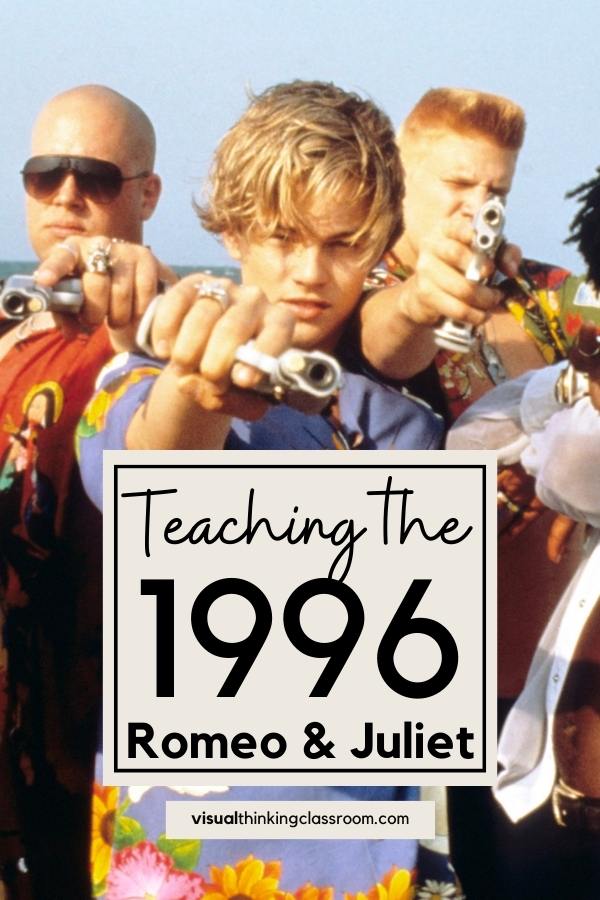
As teachers, we want to provide our students with the best possible learning experience. Part of that is finding engaging and thought-provoking material for them to study… and let me tell you there is NO BETTER way to sky rocket student engagement than to show the Romeo and Juliet 1996 movie adaptation!
The 1996 film rendition of Romeo and Juliet is a great option for those looking to add a little excitement to their curriculum. Here are some tips on how to make the most out of showing this classic film in your classroom.
The Romeo and Juliet 1996 adaptation is an excellent movie for a variety of reasons. Firstly, its director Baz Luhrmann was hailed by critics for his innovative use of modern techniques and visual flair to bring the classic Shakespearean tragedy to life in a way that was both accessible and exciting for viewers. Check out the IMBD page for the movie here.
Luhrmann’s use of vibrant colors, extreme close-ups, quick cuts and other techniques helps to make the story feel fresh while still staying true to the original source material.
On Rotten Tomatoes, the film received an audience score of 77%.
The cast also plays a huge role in making this film great. Leonardo DiCaprio and Claire Danes both give outstanding performances as the titular star-crossed lovers, perfectly conveying the characters’ emotions and bringing their relationship to life on screen.
They are buoyed by a strong supporting cast including John Leguizamo, Pete Postlethwaite, Diane Venora, Brian Dennehy and Paul Sorvino. All of these actors help to bring out an emotional complexity that many adaptations never reach.
Finally, Romeo + Juliet features some truly iconic moments that are sure to stick in viewers’ minds for years to come – from DiCaprio’s impassioned balcony monologue, Leguizamo’s hilarious Mercutio or Venora’s chillingly prophetic Lady Capulet performance.
Overall this combination of beautiful visuals, talented actors and unforgettable scenes makes Romeo + Juliet one of the best movie adaptations ever made.
Before showing the film, always review the plot with students.
Before showing the movie Romeo and Juliet to your students, spend 10 minutes and review the play from beginning to end! If this is a month long unit, it might have been four weeks since you’ve read Act 1!
The themes that are explored most prominently throughout the film include forbidden love and doomed relationships, making it an excellent point of discussion among students after viewing.
Take the time to talk about these themes with your students and frame their perspective on why this is such a classic story known across generations.
Discuss with your students what themes and messages they think the film will explore
As many teachers know, bringing classic literature to the classroom can be a great way to present timeless themes and messages. Romeo and Juliet is no exception! Before showing your class the 1996 movie of this beloved tragedy, consider brainstorming with them what themes or messages they think will be presented.
Ask them to suggest different ways in which the characters’ lives could be representative of certain lessons that can still be relevant today.
This thought-provoking conversation can serve as an introduction to the movie, as well as a reminder that true love ultimately transcends social divisions and life’s difficulties.
During the film, pause at key moments to ask your students questions about what they're seeing
Pausing during important moments in the film adaptation of Romeo and Juliet can be an incredibly powerful tool for getting your students to engage with the material in a deeper way. Watching a play written hundreds of years ago come to life on the big screen can be an eye-opening experience, and by stopping at key points you can encourage meaningful discussion about character arcs, themes, or symbolic imagery that would otherwise go unnoticed.
Plus, giving opportunities for your students to share their own interpretations of what is happening in the classic story gives them ownership over their own learning as they discover what this timeless narrative has to say about our world today!
After the film, lead a discussion about the different elements of the movie and how they related to the play
After the film is over, it would be great to lead your students in a discussion that delves into the nuances of how the movie adaptation differed from William Shakespeare’s play. Talk about why certain changes were made, why certain key points were emphasized, and which elements of the play were left out and why. Through this conversation, you can help your students develop critical analysis skills as they compare and contrast two classic works of literature. Encourage them to think deeply about how they saw these themes playing out in the movie version to gain a better understanding of the story as a whole.
Invite students to discuss what they like and dislike about the film adaptation.
Watching the 1996 movie adaptation of Romeo and Juliet can be a great way for teachers to engage their students in energizing conversations about literature. Invite your students to compare and contrast the film’s portrayal of the iconic love story with Shakespeare’s original play. Discuss which elements work well on-screen and which don’t quite hit the mark. Ask them what they appreciate or don’t appreciate about the characterizations, dialogue, acting, costumes, music, and more! Let them debate whether this modern interpretation truly captures the beauty of the classic text – or if it could have done better in its attempt to honor Shakespeare’s timeless tragedy. They might even surprise you with their insights!
Have your grabbed your FREE
Romeo & Juliet Student Folder?
Teaching Romeo and Juliet 1996 through the movie adaptation can be a fun, learning-filled experience that your students will enjoy. Providing them with a synopsis of the story before watching will ensure that everyone is on the same page before beginning.
Asking questions during key moments in the film will help your students to better analyze and understand what is being shown onscreen. Finally, have a discussion once the film is over to help further promote critical thinking skills and understanding of the themes present in both the play and its adaptation.
This type of activity will help bring Romeo and Juliet 1996 to life – novel in one hand and cinema on another! – in a way that is sure to capture your students’ attention and interest.
Check out my blog post about why I always show the 1968 version of Romeo and Juliet act by act as we read.

Carley 📚 Teacher Author @ Visual Thinking Classroom
B.A., B.Ed., Graduate Certificate in Teacher Librarianship // carley@visualthinkingclassroom.com


